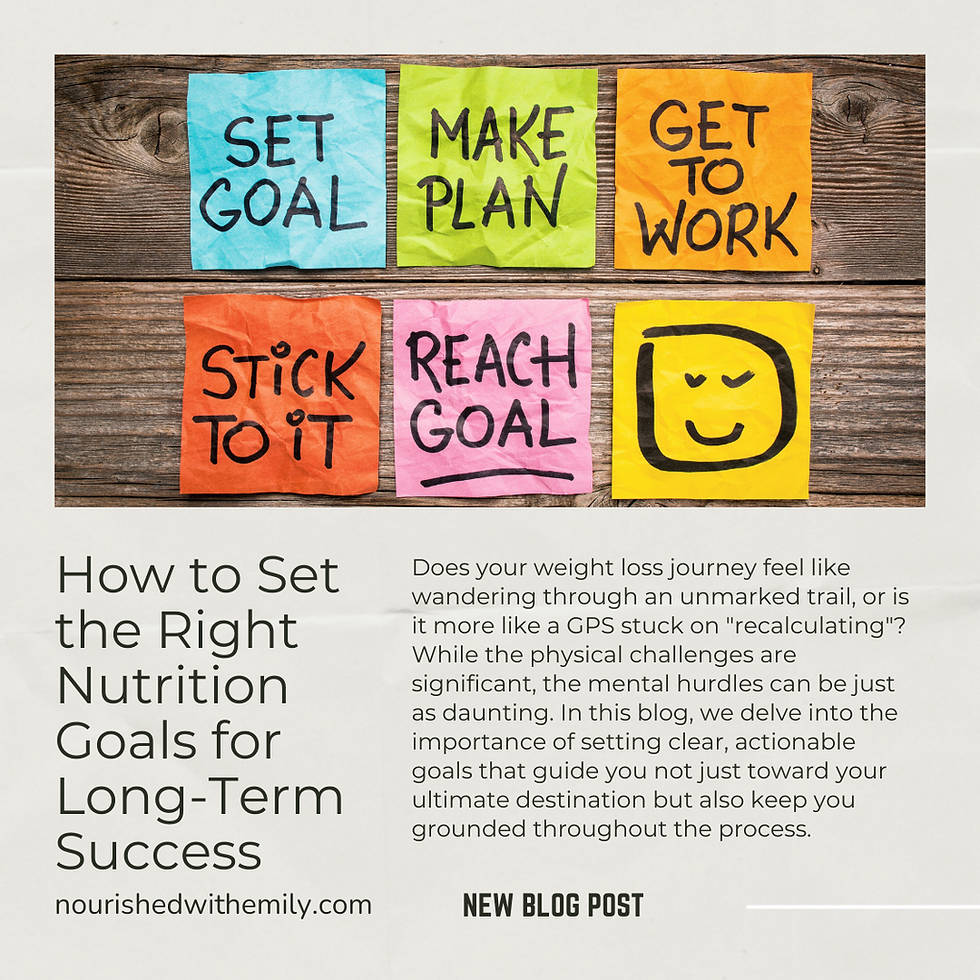How to Set the Right Weight Loss Nutrition Goals for Long-Term Success
- emilytillsrd
- Oct 2, 2024
- 4 min read
Updated: Feb 3

Does weight loss feel like a trail without a worn-down path or markers to keep you on course? Or is it like a GPS that keeps saying "recalculating" at every turn? Weight loss is challenging—not just for our bodies but also for our mental well-being. One way to ease this process is by setting goals—not just goals for where we want to be at the end, but goals that help keep us on track throughout the entire journey. These goals can indicate whether we are thriving or merely treading water.
In this blog, we will explore how to set the right nutrition goals for long-term success and provide examples to help you get started.
We will cover:
Why goals matter
Where to start with setting goals
How to make SMART goals
Examples of goals to help you get started
Why Goals Matter
Have you ever heard the saying, "A goal without a plan is just a wish"? Or felt the desire to change and progress but didn’t know where to start or what you wanted to accomplish? When we aim for change without a clear target, navigating the path can become challenging. Setting goals not only helps clarify what we wish to achieve, but it also allows us to design a pathway to get there.
Let’s practice this. Take two minutes to think about your health and nutrition—where you are right now, what’s working, and what isn’t. Then, picture yourself in six months. What do you see? What are you doing? What does the future look like? What hobbies and habits does your future self engage in? This can initiate the brainstorming process for goal-setting. The desire to change usually stems from a craving to feel or be better. We move away from pain and discomfort because we yearn for something more. When you set goals, you're not just identifying a target; you're also outlining your path and defining your values.
Where to Start with Goal-Setting
Once you decide to make a change, you need to envision the finish line of your journey. Your goals might focus on weight loss, reducing cholesterol and triglyceride levels, reversing diabetes, or training for a marathon. Regardless of the specific goals, it’s essential to determine your endpoint, as well as the mile markers and checkpoints along the way to maintain momentum. While setting a big goal is valuable, it’s easy to lose sight of progress when the endpoint feels distant. Consider setting smaller milestones to help maintain momentum and celebrate successes.
How to Make SMART Goals
After determining your endpoint, think about the necessary processes and changes to achieve it. Start by creating awareness of your current habits, behaviors, and routines. A great way to do this is by keeping a food log for one week. Don’t change anything about your eating; simply track and observe your choices, meal timing, and how you feel after each meal. At the end of the week, review your days critically to identify strengths and weaknesses in your meals.
You can apply this same approach to other habits and routines. Create a 24-hour log to track time spent on various activities—scrolling through your phone, watching TV, working, snacking, and eating. Identify time-sucks in your day, such as excessive social media use or TV watching. Could you fit in a 10-minute walk?
Once you’ve audited your current situation, consider the changes you can implement for success. When setting mini-goals, aim for SMART criteria:
Specific
Measurable
Attainable
Realistic
Time-bound
For example, instead of setting a vague goal to work out this week, you might say, "I will go to the gym for a 30-minute walk on the treadmill at least three times this week after work." The more specific your goal, the more likely you are to achieve it.
Examples of Goals for Getting Started
Setting the right goals and focus for each week can make or break your progress. Here are some examples we encourage our clients to consider as they begin their weight loss journey:
I will drink at least 30 ounces of water by lunchtime at least 5 out of 7 days.
I will eat three meals a day on the weekends.
At least two of my meals each day will include protein, carbohydrates, and healthy fats (PCC).
I will sign up for and attend two spinning classes this week.
I will create a three-day meal plan on Sunday and go grocery shopping.
I will brush my teeth after dinner to prevent snacking before bed.
Notice that none of these goals focus directly on weight or weight loss. Instead, each goal emphasizes the process that contributes to weight loss. We cannot control the scale directly, but we can make changes to our routines and lifestyles that encourage the scale to move. Keeping this in mind is crucial as we focus on weight loss.
Embarking on a weight loss journey can feel overwhelming, but setting the right goals and creating a supportive structure can make all the difference. By focusing on actionable, process-oriented goals, you can build momentum and foster lasting change in your life.
If you're ready to take your journey to the next level, we invite you to join our membership for just $29 a month. With our program, you'll gain access to food tracking with personalized feedback, weekly goal setting and accountability, delicious recipes, monthly classes, and Q&A sessions. Together, we’ll navigate your path to success, ensuring you have the support and resources you need every step of the way. Join us today and start transforming your goals into reality!

Comments